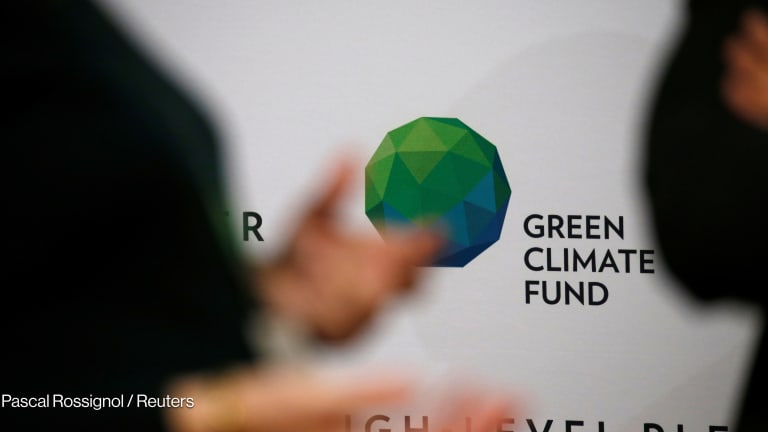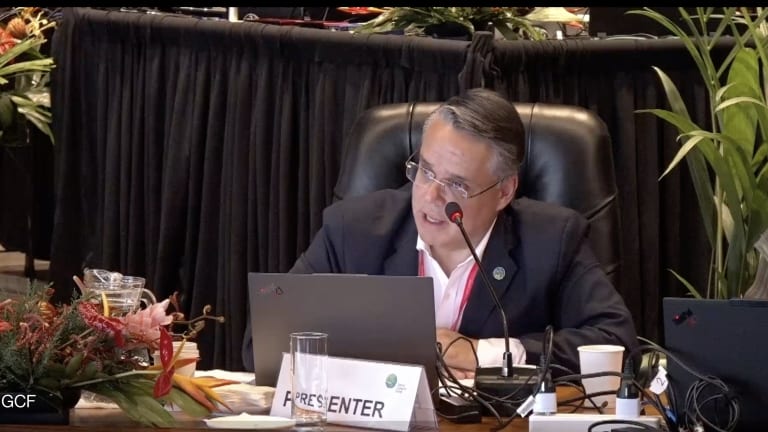Exploring GEF’s climate funding footprint
As the Global Environment Facility plans to mobilize more climate funding, Devex looks at data spanning nearly 30 years to garner insight into investment levels, focus areas, and locations — helping to put new funding allocation into context.
In June, just a few months into the global pandemic, the Global Environment Facility agreed to allocate $700 million for projects and programs to help low- and middle-income countries continue advancing urgent environmental priorities through, and beyond, the COVID-19 crisis. Meeting online on June 2, GEF’s governing body agreed that the new and expanded programming under the replenishment cycle would include oceans, land use, wildlife trafficking, climate change adaptation, and helping vulnerable countries and communities to build climate resilience. The facility — an international partnership of 184 member countries, plus international institutions, civil society organizations, and the private sector — also outlined plans to mobilize $3 billion in co-financing from other sources that would directly benefit 12 million local people. Since 1992, GEF has been addressing global environmental issues, providing funding to assist LMICs in meeting international environmental objectives, and serving as a financial mechanism for environment conventions and partners with 18 institutions that act as GEF agencies — including United Nations agencies, multilateral banks such as the World Bank or the Asian Development Bank, and other organizations including the World Wide Fund for Nature or Conservation International, among others. Now, in the midst of the coronavirus pandemic and economic crisis, potential changes are on the horizon. New CEO and chairperson, Carlos Manuel Rodríguez — who took over from former CEO Naoko Ishii at the beginning of August — told Devex in an interview that with the impacts of climate change and biodiversity collapse just around the corner, GEF needs to review its partnership in terms of mobilizing resources, from all sources, like never before. “If we continue funding the GEF the way we have done it in these 25 plus years, we will never become a global agent of change,” Rodríguez said. He added that GEF is potentially positioned to “create consensus on how to be more efficient and focused on the mechanisms that have proven to be effective in implementing multilateral environmental agreements.” Devex Analytics explored GEF project data from 1991 to 2020 in order to provide insight into its investment levels, focus areas, and locations — with the aim of putting this new funding allocation into context. How much is GEF mobilizing? According to Rodríguez, GEF mobilizes just a small fraction of the global resources allocated to nature conservation or sustainability each year. Since it began operations, including its pilot phase, GEF has invested more than $20.5 billion in grants and other support and mobilized an additional $112 billion in co-financing through more than 4,800 projects to protect the environment in LMICs. “Mobilized funds” refers to the funding provided by co-financiers — usually other international finance institutions like development banks or the recipient government — to GEF projects. Structured by 4-year investment cycles, also called replenishments, GEF has gone through seven since its inception. The last one, GEF-7, was in 2018 and donor countries pledged $4.1 billion in contributions. So far, in this current investment cycle that lasts till 2022, it has allocated 61% of its seventh replenishment resources, including the June 2020 work program. Climate change is the top focal area GEF programming is organized by focal areas or sectors as it provides active support across multiple dimensions of environmental action. These have changed over time in alignment with the international agreements for which GEF acts as a financial mechanism. For example, while ozone layer depletion was a focal area until 2012, it is now included as a topic in the chemicals and waste focal area. According to the available project data on the GEF website, the three focal areas that have existed since the beginning are: biodiversity, climate change, and international waters. Out of all projects, approximately 21% had more than one focal area, therefore we cannot allocate the full amount of the project to a given focal area, as it might only make up a fraction of it. According to GEF, climate change accounts for 31.6% of the cumulative funding approvals since the GEF inception phase to end of April 2020, including the June 2020 work program. If we zoom in on the current investment cycle, GEF-7, climate change resources under approved projects stands at 28%. Who manages GEF projects? While only countries are eligible to apply for GEF funding, one of the established 18 GEF agencies will be the one leading the development of the project supporting the government and the organizations executing it. The top agency by number and value managed projects and program financing is the U.N. Development Programme with 30.1% in GEF- 7. The World Bank follows with 19.9% and the Food and Agriculture Organization with 15.4%. The U.N. Environment Programme is also a traditional top GEF agency, managing 14.9% of the GEF-7 investment portfolio. It usually handles projects of less value than the World Bank in comparative terms. In the top-10 ranking we can also find U.N. agencies such as the U.N. Industrial Development Organization, NGOs like Conservation International, and major regional development banks like the African Development Bank, ADB, Inter-American Development Bank, and the European Bank for Reconstruction and Development. Where did GEF mobilized resources go? According to the GEF project data, 20% of GEF’s total projects to date have a regional or global scope. The geographical distribution of GEF-supported projects depends on country demand and reflects GEF’s resource allocation framework which has evolved over time. GEF’s resource allocation framework currently takes into account several factors including the Global Benefits index, GEF portfolio performance and institutional assessment, and gross domestic product. From GEF’s inception through GEF-6, China accounted for 153 national projects — as opposed to multicountry projects — followed by India with 75 projects, then Mexico, Brazil, and Vietnam. Altogether, China represents 3% of the number of projects approved since GEF’s inception. Over time, the share of projects in China in terms of financing volume has decreased, from 13% in GEF-1 to 5% of the portfolio in GEF-6. In GEF-7 to date — we are currently at the midpoint in the four-year cycle — China has seven projects approved; Mexico has six projects, Ecuador, India, Indonesia, the Philippines, and Thailand each have five projects; and Rwanda and Sudan have four projects. Who owns funding climate change? When thinking of climate change funds, the Green Climate Fund is likely to come to mind. It was set up by the U.N. Framework Convention on Climate Change in 2010 and it defines itself as the world’s largest dedicated fund helping LMICs countries reduce their greenhouse gas emissions and enhance their ability to respond to climate change. In 10 years, the GCF board has approved $5.3 billion mobilized for climate change adaptation and mitigation — and when adding co-financing the total goes up to $18.9 billion. As explored above, about a third, approximately $6.5 billion, of GEF’s investments since inception in the early ‘90s have been in the climate change focus area and the percentage is similar in the current GEF-7 investment cycle. So who owns funding for climate change? “If you see how many institutions there are globally with a responsibility to implement the international environmental agreements and be able to work in a cost-effective manner, the GEF is very well situated,” Rodríguez said. According to a GEF spokesperson, the facility is collaborating with other climate funds and programs, including GCF, to address gaps and minimize overlap in and between countries. It has already conducted the first joint planning and programming of GEF and GCF resources at country level. They are also discussing partnership opportunities around major initiatives related to land restoration, electric mobility, the Amazon, and the Great Green Wall, among others. With a new GEF CEO who wants to focus on “efficient multilateralism,” review “how to mobilize resources and negotiations are set,” and have a “global conversation on how we redefine the U.N. agencies and their roles and how we redefine the multilateral environmental agreements,” more coherence, collaboration, and complementarity, could be expected, especially since both GEF and GCF are playing roles in the new arena of blended finance by de-risking scalable projects. Michael Igoe contributed reporting to this piece. Update, Oct. 1, 2020: This article has been updated to clarify GEF membership. Update, Aug. 10, 2020: This article has been updated to clarify that regional and global projects account for 20% of GEF’s total projects to date.
In June, just a few months into the global pandemic, the Global Environment Facility agreed to allocate $700 million for projects and programs to help low- and middle-income countries continue advancing urgent environmental priorities through, and beyond, the COVID-19 crisis.
Meeting online on June 2, GEF’s governing body agreed that the new and expanded programming under the replenishment cycle would include oceans, land use, wildlife trafficking, climate change adaptation, and helping vulnerable countries and communities to build climate resilience. The facility — an international partnership of 184 member countries, plus international institutions, civil society organizations, and the private sector — also outlined plans to mobilize $3 billion in co-financing from other sources that would directly benefit 12 million local people.
Since 1992, GEF has been addressing global environmental issues, providing funding to assist LMICs in meeting international environmental objectives, and serving as a financial mechanism for environment conventions and partners with 18 institutions that act as GEF agencies — including United Nations agencies, multilateral banks such as the World Bank or the Asian Development Bank, and other organizations including the World Wide Fund for Nature or Conservation International, among others.
This story is forDevex Promembers
Unlock this story now with a 15-day free trial of Devex Pro.
With a Devex Pro subscription you'll get access to deeper analysis and exclusive insights from our reporters and analysts.
Start my free trialRequest a group subscription Printing articles to share with others is a breach of our terms and conditions and copyright policy. Please use the sharing options on the left side of the article. Devex Pro members may share up to 10 articles per month using the Pro share tool ( ).
Raquel Alcega leads the data research and analysis at Devex, providing advice to organizations on the latest funding and programmatic trends that shape the global development space. She also heads up the news business content strategy and designs internal knowledge management processes. Prior to joining Devex’s Barcelona office, she worked in business development in Washington, D.C., and as a researcher in Russia and Mexico.








